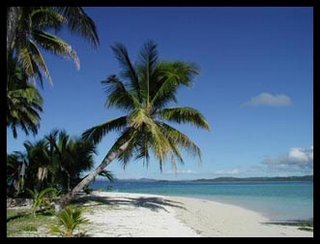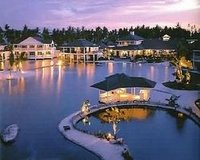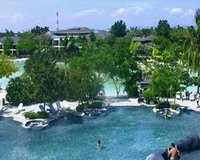Travel & Leisure
Travel Now!
Tuesday, December 05, 2006
Sunday, November 12, 2006
Siargao Island: Hidden Tropical Jewel and the Philippine Surfing Capital
Surigao del Norte is a medley island
 in the northeastern tip of Mindanao. A province that has managed to preserve its natural marvel through the years. On the eastern side of the province is Siargao Island, a hidden tropical jewel of the Pacific that hosts one of the most beautiful beaches in the world and home of wave surfing and the famous CLOUD 9, the latest sport and tourist attraction to take the country by storm It is the Surfing Capital of the Philippines. The best known surfing break now with a world reputation of being in the top Surfing Waves in the world, is nick-named "Cloud Nine". But there are literally scores of breaks down this coast, and every time a surfing expedition is mounted in the area, more new breaks are being discovered.
in the northeastern tip of Mindanao. A province that has managed to preserve its natural marvel through the years. On the eastern side of the province is Siargao Island, a hidden tropical jewel of the Pacific that hosts one of the most beautiful beaches in the world and home of wave surfing and the famous CLOUD 9, the latest sport and tourist attraction to take the country by storm It is the Surfing Capital of the Philippines. The best known surfing break now with a world reputation of being in the top Surfing Waves in the world, is nick-named "Cloud Nine". But there are literally scores of breaks down this coast, and every time a surfing expedition is mounted in the area, more new breaks are being discovered.Siargao is a tear-drop shaped island situated 800 kilometers southeast of Manila in the province of Surigao del Norte. It has a land mass of approximately 437 kilometers. It has a land mass of approximately 437 kilometers. The east coast is relatively straight with one deep inlet-Port Pilar with a coastline marked by a succession of reefs, small points and white sandy beaches. There are similar neighboring islands and islets with similar landforms. The reefs and points are excellent for picking up any swell that comes along turning into clean, fast waves. The Island's Pacific-facing reefs are situated on the edge of the Philippine Trench, and the extremely deep offshore waters guarantee the ocean swells have undiluted power when they encounter the many coral and rock reefs, giving Siargao excellent surfing conditions, particularly
 during the southwest "habagat" monsoon from August to November, when the prevailing wind is offshore.
during the southwest "habagat" monsoon from August to November, when the prevailing wind is offshore.Siargao Island, faces the Pacific Ocean and the Philippine Deep, the second deepest water in the world, at more than 11 km below sea level. The area is pure tropics with the plenty activities including snorkeling, island hopping, waterfalls, swimming holes and of course awesome waves and friendly locals.
This right-breaking reef wave is the site of the annual Siargao Cup, a domestic and international surfing competition sponsored by the provincial government of Surigao del Norte. The wave was discovered by travelling surfers in the late 1980's, and named and made well-known by American photographer John S Callahan, who published the first major feature on Siargao Island in the US based SURFER Magazine in March 1993, and hundreds of photos in many other books and magazines since. Callahan has returned to the island many times since his first visit in 1992, and his efforts to photograph and publish surfing related and general location material from Siargao islandin books and magazines around the world has put the island on the international map and drawn thousands of surfers and tourists to Siargao island.
There are several other excellence waves on Siargao and nearby islands, but Cloud 9 has received more publicity than any other wave in the area, indeed in the Philippines as a whole. It is the only wave in the area easy to get to without a boat, leading to overcrowding and the nickname of "Crowd 9" among surfers worldwide as keen foreign and locally owned accommodation and t
 ourist facilities attempt to profit from the magazine publicity and the annual arrival of visitors drawn by the Siargao Cup competition in September.
ourist facilities attempt to profit from the magazine publicity and the annual arrival of visitors drawn by the Siargao Cup competition in September.Siargao Islands contain the biggest mangrove forest reserves in Mindanao on the opposite coastline. Long stretches of wetlands equally indicate potentials for commercial seaweed propagation. Siargao Island is greatly influenced by the winds and currents coming uninterrupted from the Pacific Ocean, intensified by the Mindanao current running westward through the Siargao Strait.
Offshore, a classic tropical island lay secluded within its surrounding coral reef and the dozen coconut palms dressed in the center circle of the island crackle gently in the morning breeze. Off to the right, well within the massive coastal reef, lay a shining white sand bar some 200 meters long, maintained by a group of some forty black-headed terns that stood chattering among themselves at the waters edge. The tide of Siargao is diurnal with tidal curves typically present especially on the east coast of the island.
Thursday, November 09, 2006
Philippines: The Plantation Bay Resort and Spa

The hotel is situated in 11.4 hectares of secluded grounds yet only 30 minutes from downtown Cebu City, Plantation Bay offers one of the largest privately-owned waterways in the world, with the clean elegance of colonial-plantation architecture. Decompress from life's pressures in the healing tranquility of an environment that truly feels "away from it all". If you have ever spent time at a tropical plantation, you know what we mean. If not, come and discover a refreshingly different Flavor of Life.
Whether you're traveling for a family vacation or romantic getaway, for business or pleasure, this is far and away your best choice in the Philippines.
The hotel rooms are a full 46 square meters (460 square feet), charmingly furnished with plantation-style furniture, oil paintings, and accessories; equipped with remote-control TV, mini-bar, electronic safe, and split-package air-conditioning.

And you'll love the bathrooms - spacious, with coral stone and marble finishes, separate shower and deep tub, hair-dryer, and extension phone.
In the area of food, most resorts under-perform and overcharge. At Plantation Bay we believe good food is an essential component of good hospitality, and work hard to offer our guests a stimulating choice of international dishes (see some of the dishes we're most proud of, and why) at reasonable prices (see sample prices).
Due to its unique geology and location in the inland Philippine Sea, totally surrounded by much larger islands, Cebu-Mactan is safer than most other resort areas in the world
At some hotels, there are a token few rooms with nice views (for the brochures!), while most guests get stuck with parking lot or "garden" views. At Plantation Bay you are assured of a splendid, take-your-breath-away vista from almost every room.
The most-acclaimed resort in the country is also the foremost Philippine spa. Plant
 ation Bay's Mogambo Springs offers an ambience and treatment experience comparable to those of leading spas in Bali, Thailand, or California, at a fraction of the price.
ation Bay's Mogambo Springs offers an ambience and treatment experience comparable to those of leading spas in Bali, Thailand, or California, at a fraction of the price.All our guests receive the highest standard of personal attention without ever having to worry when, whom, or how much to tip. If you've never been in a No-Tipping resort, you just don't know what you're missing. Why not find out?
Many leading resorts offer extensive facilities, terrific food, and lovely rooms. But, regardless of the purpose of your visit, the one element that sets Plantation Bay apart from all the others is the absolutely authentic "feel" it recreates - like distilled Essence of Plantation Living, suffused with a sense of serenity and timelessness that you will remember and want to come back to.
Wednesday, November 08, 2006
Philippines - Pearl Farm Beach Resort

The Parola Wharf, Pearl Farm’s endearing symbol, welcomes guests to a showcase of culture and warmth of the southern Philippines.
Located in the southern part of the Philippines is the Samal group of Islands, an archipelago consisting of nine islands which stretch out over a land area of 28,000 hectares. Samal is a beautiful, tranquil and exotic island with a coastline adorned with white sand beaches, abundant marine life, rock formations, mangroves, and landscape elements of coconut palms, flowering plants and fruit-bea
 ring trees. The area is blessed with various natural attractions and flourishing flora and fauna.
ring trees. The area is blessed with various natural attractions and flourishing flora and fauna.Nestled on the quiet side of Samal Island, The Pearl Farm Beach Resort is a mere 45-minute boat ride from the wharf. This fourteen (14) hectare spread was once a pearl farm, where thousands of white-lipped oysters transported from the Sulu Sea, were cultivated for their pink, white and gold pearls. Today, the resort beckons with the promise of a relaxing, private retreat, under the care of its friendly and charming staff.
Tuesday, November 07, 2006
Philippines - Amanpulo

amanpulo was created for travelers seeking the idyllic beauty of an exclusive tropical island. Situated on the private island of Pamalican, 200 km east of Palawan in the Philippines, the 220 acre isle is surrounded by white sand, crystal clear sea and well preserved coral reefs (50-300 m. offshore). Guests arrive from Manila by chartered plane which lands directly on Pamalican.
The surrounding waters yield a wide variety of marine life and dive sites. The average temperature is 26 deg. C with underwater visibility ranging between 15-30 m., superb for all water activities: swimming, sailing (hobiecats, lasers and windsurfers), rowing, fishing, boat trips, snorkeling and scuba diving, ranging fro introductory to advanced, are also available (some with certification).
In addition to watersports, Amanpulo offers guided eco-walks, cycling, tennis, picnicing, and massage in the privacy of one's casita.
The resort's main building, The Clubhouse, contains The Restaurant and its terrace, The Lobby and Bar, The Library, Art Gallery and Boutique. The Beach Club is a short walk awa
 y. All watersport facilities, except scuba diving, are available from the Beach Club. The Dive Shop is a five-minute golf cart ride from The clubhouse.
y. All watersport facilities, except scuba diving, are available from the Beach Club. The Dive Shop is a five-minute golf cart ride from The clubhouse.40 airconditioned casitas are set amongst beachfront or hillside vegetation. Designed as a Filipino bahay kubo, all casitas feature polished timber floors, kingsize beds, window divans, CD players, spacious bathroom and dressing areas, sunken baths, and private outdoor terraces for lounging and dining. Each casita comes with its own battery operated cart for traveling around the island.
Guest facilities include a restaurant; bar; lobby lounge with antique panolongs from Mindanao; library with a large selection of books, magazines, CD's and boardgames; boutique and art gallery featuring Filipino artifacts, antique jewelry and clothing; meeting room; picnic grove; beach club; swimming pool; day and night all-weather tennis courts; and 24-hour room service.
The island's weather is tropical, with a dry season from November to May and scattered rain showers from June to October. The mean annual temperature is 27.2oC (81oF). January is the coolest month, with an average temperature of 25.5oC (78oF) and May the hottest at 29oC (84oF).

Time Difference Pamalican Island is eight hours ahead of GMT and the same time zone as Manila. Language Filipino (Tagalog) is the official language. English is used for business and legal transactions and is spoken almost everywhere.
Guests are met at Manila's international airport and taken by complimentary cartransfer to Amanpulo's lounge. From there, they are flown by private charter directly to Pamalican Island. Visitors to the Philippines must have a valid passport. Most passport holders are allowed entry without a visa for up to 21 days provided they have valid return tickets.
Travel & Leisure
This blog is for all people who love to travel. I will be featuring different vacation/holiday getaway everyday. Each week I will be featuring travel destinations from different countries. Of course, I will start from the place which I grew up -- The Philippines. Hope this will help you in deciding where to spend your next holiday.

